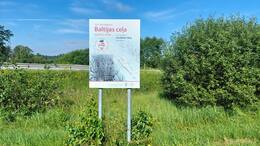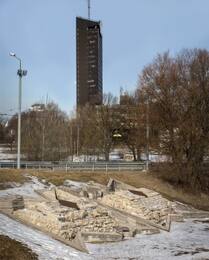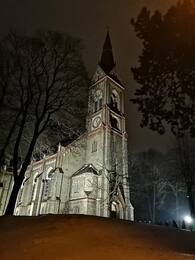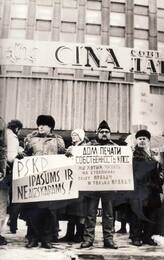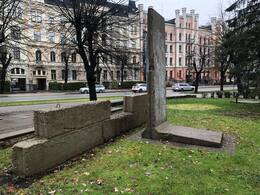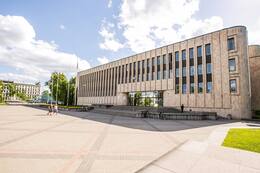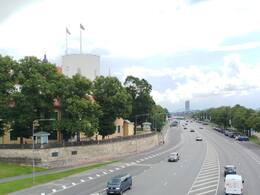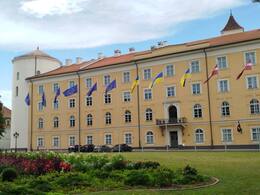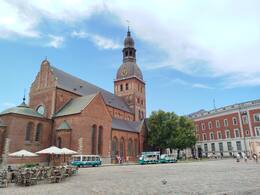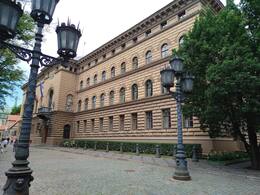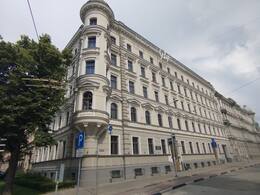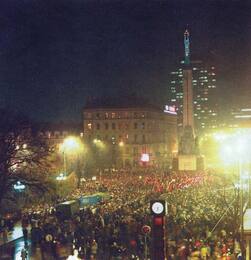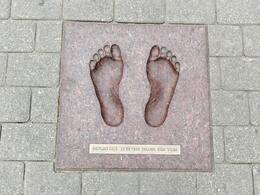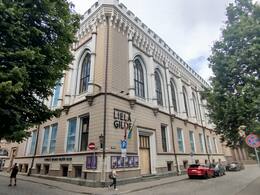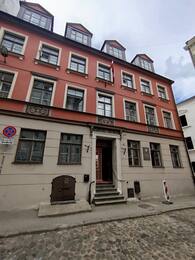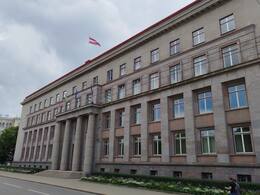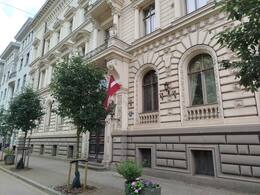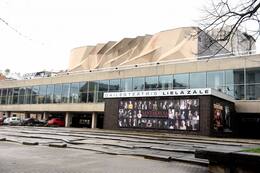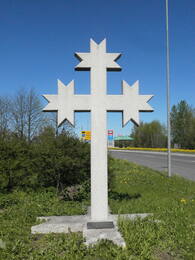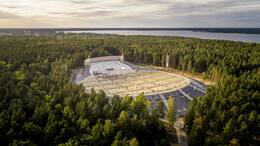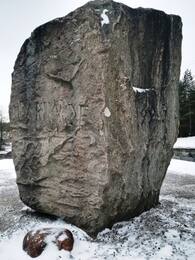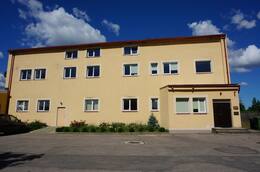From the Awakening to the restoration of Latvia's independence
Commemorative sign dedicated to the 25th anniversary of the Baltic Way
During the campaign “Baltic Road” on August 23, 1989, people from Kurzeme and Zemgale - Liepāja, Saldus, Dobele, Kuldīga, Ventspils, Talsi, Tukums and their surroundings arrived on the Riga - Bauska highway section. The main task was to achieve the most even distribution of people and continuity of the chain. Where there was not enough arm length, people were asked to use flags, belts, or even jacket sleeves, just so that the blood circulation of community in this artery would not be interrupted. In total, about 400,000 Latvian residents participated in this campaign.
The memorial sign dedicated to the 25th anniversary of the Baltic Way in Ķekava municipality, at the 25th kilometer of the Riga-Bauskas highway near the Ķekaviņa River, was unveiled on August 23, 2014. Its ceremonial opening was attended by the Prime Minister of the Republic of Latvia, Laimdota Straujuma, a long-time employee of the State Joint-Stock Company “Latvijas Valsts ceļi” and a member of the Baltic Way, Uldis Birzleja, and other attendees. In 2014, 10 such memorial signs were erected on the Baltic Way section of Latvia in memory of this event. Four memorial signs were erected in Estonia, and nine in Lithuania. On July 30, 2009, the Baltic Way campaign was included in the UNESCO “Memory of the World” documentary heritage list.
Barricades Memorial "Eyes"
The environmental art object “Eyes”, created by Igors and Ruta Dobičin in 1991 (restored in 2012) in memory of the barricades, is dedicated to the 30 x 60-meter square. Dolomite and concrete pile and paving elements, similar to graphic signs, are placed in the 30 x 60-meter square, forming a cryptogram resembling a stylized “face”. A plaque is built into the symbolic ensemble with the inscription: “Eyes. Dedication to the guards of the Television Center during the barricades in 1991. There is strength in unity”. In 1991, a sculpture by Ojārs Feldbergs “By the Fire” was installed near the LTV building. The two-meter-high sculpture, carved in granite, contains a metaphor for people from four Latvian regions gathering around a common fire.
Television, like radio and the printed press, played a very important role during the Awakening not only as a source of information, but also as a driver of this process. The LTV program “Labvakar” (Good Evening), launched on January 31, 1988, gained immense popularity. It was the first program in Latvia in which Edvīns Inkēns, Ojārs Rubenis and Jānis Šipkēvics spoke about many previously forbidden topics. LTV broadcast live broadcasts from Latvian Popular Front congresses and mass demonstrations, and produced interviews and reports on politically important issues.
During the barricades in January 1991, the LTV building was one of the important objects guarded by volunteers. This was a difficult task, as the building is located in a large and easily accessible area. The barricades participants guarded the direct approaches to the building, as well as blocked the Salu bridge at night. From the Daugava side, the LTV center was guarded by three fishing boats. Remaining intact during the barricades, the LTV building was invaded by paratroopers of the USSR Army and members of the OMON unit during the August 1991 coup. After it was captured on August 19 at 7:30 p.m., the TV stopped broadcasting, but resumed its work after the coup failed and after the Soviet paratroopers left the LTV building on August 21 at 7:45 p.m.
Riga Lutheran Evangelical Lutheran Church
In the second half of the 1980s, meetings of the “Revival and Renewal” movement were held at Torņakalns Church. It was a group of pastors and parish activists of the Latvian Evangelical Lutheran Church, which on June 14, 1987, distributed a document on the founding of the group and its goals with an invitation to all LELB clergy to join this group. The group invited Archbishop Īriks Mesters and the Consistory to address the Councils for Religious Affairs of the Latvian SSR and the USSR with a request to jointly discuss, evaluate and possibly revise some points of the Regulation on Religious Associations of the Latvian SSR, which no longer correspond to the real situation and hinder the democratization process in the church.
On July 28, 1987, the first meeting of the group took place, where the basic principles of the organization renamed the "Revival and Renewal" movement and proposals on church-state relations and the internal life of the LELB were adopted. The LELB Consistory, under the leadership of Archbishop E. Mester, in July and August 1987, carried out repressions against members of the "Revival and Renewal" movement Jānis Priednieks, Roberts Akmentiņš, Aivars Beimanes and Modris Plātes, removing them from their positions. In December 1987, members of the movement Māris Ludviks and Jānis Kārkls were forced to leave Latvia. In April 1989, at the LELB Synod, members of the movement became the leaders of the LELB, and Kārlis Gailītis became the archbishop.
Arcadia Park
On April 27, 1988, about 10,000 people protested against the construction of the metro in Riga at a rally organized by the Environmental Protection Club in Arkadija Park. The demonstration began on the Esplanade at the Rainis Monument, but continued with a march along the Freedom Monument across the Stone Bridge to Arkadija Park, stretching for 2.5 kilometers. It was the first large rally of the Awakening era – unauthorized, but not prohibited. The Arkadija branch of the VAK held its meetings in the wooden building of the former Arkadija cinema (burned down in 2006, demolished two years later). Environmental activists gathered here, among whom ideas about nature protection were born, which gradually grew into demands for the restoration of Latvia’s independence.
In the summer of 1988, the Arkadija Park stage (burned down in 2000) was a gathering place for the radical national opposition. On July 10, the founding meeting of the Latvian National Independence Movement was held in the park, which was attended by about 2,000 people. As a venue for various mass events, Arkadija Park retained its importance throughout the Revival period. In November 2023, information stands of the municipal agency “Rīgas dārzi un parkis” “The wooden building of the Arkadija Cinema – one of the shacks of the Third Revival” and “Protest against the construction of the Riga Metro – the beginning of the restoration of Latvian independence” were installed in Arkadija Park.
Former Press House building
The publishing house and printing house complex built in 1978 housed the editorial offices of all newspapers and magazines of republican importance. Journalists played a very important role in the course of the Awakening, as their presence in the Press House facilitated mutual contacts and organization. It was here that the Latvian People's Front began to take shape. The idea of the need for such an organization was expressed at the plenum of the Creative Unions on June 1-2, 1988, and already on June 22, Viktors Avotiņš read its first, unpublished manifesto at a meeting of journalists. However, the idea was only realized after the Writers' Union and its chairman, Jānis Peters, became involved in its implementation.
The Press House belonged to the Central Committee of the Communist Party of Latvia, which had taken over and effectively monopolized the publication of all newspapers and magazines of republican significance. All profits from the publishing house and printing house went to the treasury of the Central Committee of the Communist Party of Latvia. During the Awakening, as efforts to restore Latvia's independence intensified, the issue of ownership rights to the Press House also arose. After the adoption of the Declaration of Independence on May 4, 1990, a dual government was effectively formed, as some Latvian institutions refused to submit to the government of the Republic of Latvia. The Latvian government established the Latvian Newspaper and Magazine Publishing House, but the USSR Council of Ministers and the Central Committee of the Communist Party of Latvia led by Alfred Rubiks considered the Press House to be the property of the USSR. The situation escalated in November 1990, when OMON attacks on the Press House took place, but on January 2, 1991, OMON completely took over the Press House and stopped printing publications supporting the LTF, expelling their employees from the Press House.
Demolition work on the Press House printing house began in 2020. The construction of the Press House block is currently underway, which will completely change its former appearance.
Monument "The Wall - Divider and Uniter"
The memorial site at Elizabetes Street in Kronvalda Park was opened in September 1992 after a fragment of the dismantled Berlin Wall was exhibited in Riga. In 1992, it was combined into a single memorial ensemble with a fragment of the concrete wall erected near the Saeima building during the 1991 Barricades and installed in Kronvalda Park at Elizabetes Street, next to the World Trade Center. An altar for laying flowers is attached to the monument with an inscription in Latvian and German: “After the exhibition of the Berlin Wall Museum “Haus am Checkpoint Charlie” in Riga in November 1990, the museum director Dr. Rainer Hildebrands presented this fragment of the wall to the capital of Latvia.”
In 2011, the monument was restored and the territory was improved. An information plaque with text in Latvian, German, English and Russian was installed. The barricade blocks were supplemented with historical inscriptions in Latvian and Russian: “The Berlin Wall divided us, the Riga Wall unites us. Let us only love our neighbor, and pray to God for our enemy.”
Riga Congress Center
The Congress Hall (at that time the Political Education Hall of the Central Committee of the Communist Party of Latvia) was one of the few meeting rooms in Riga where a larger number of people could gather. During the revival, a variety of events were held there - congresses of the Latvian Popular Front, founding events for various public organizations, discussions on history, etc. On June 1-2, 1988, an expanded plenum of the board of the Latvian Writers' Union was held here with the participation of other creative unions, to which the leadership of the Latvian SSR was invited. Many painful problems were discussed, but the effect of a bombshell was created by the speech of the well-known political commentator and 1940s activist Mavriks Vulfsons, in which he declared that there had been no socialist revolution in Latvia in 1940.
On June 14, 1988, a rally was held in memory of the victims of mass deportations at the Congress House. It was the first officially authorized rally, at which both officials (for example, the Secretary of the Central Committee of the Latvian Communist Party Anatolijs Gorbunovs) and representatives of the public (journalists Andrejs Cīrulis, Edvīns Inkēns, a representative of the Environmental Protection Club Valdis Turins, a priest Juris Rubenis, dissident Eduards Berklavs, etc.) spoke. The rally ended with a march to the Freedom Monument. During the march, Konstantīns Pupurs carried the Latvian flag. Many posters at the rally were quite radical, for example, "No — to the histories of Drīzulis and Karaļuns", "No to the kangaroo Voss of our day!" Modris Lujāns held a poster on which were pasted photos of Stalin and Ribbentrop with the caption "Curse on the murderers of the people" and photos of August Voss and other leaders of the Latvian Communist Party with the caption "No to the kangaroos!" A few days later, at the plenum of the Central Committee of the Latvian Communist Party, First Secretary Boriss Pugo condemned certain individuals and groups who “under the guise of reorganization tried to give the rally a distinctly nationalistic, provocative orientation.” A criminal case was initiated against M. Lujāns, but on September 30 the Supreme Court of the Latvian SSR fully acquitted him.
The next turning point in Latvian history was the 1st Congress of the Latvian Popular Front on October 8-9, 1988, which was also held at the Congress House. On December 10-11, the Forum of the Peoples of the Latvian SSR was also held here.
Daugavmala (11. November Embankment)
The Daugavmala or 11 November embankment between the Akmens and Vanši bridges in Riga was the site of popular demonstrations in 1989-1991. The largest of them were the demonstration "Let's prevent threats to the democratization process!" organized by the Latvian Popular Front on March 12, 1989 (200-250,000 people), the demonstration "For an independent Latvia" on November 18, 1989 (600,000 participants), and the Supreme Council pre-election demonstration "Both sides of the Daugav will never be divided" organized by the LTF on March 17, 1990.
On the night of January 13, 1991, Soviet army tanks surrounded the building of the Supreme Council of Lithuania, Soviet soldiers seized Lithuanian TV, radio and telegraph, killing 14 and wounding 110 civilians. At 4:45 AM, LTF Chairman Dainis Īvāns called on Latvian radio to defend the country's most strategically important buildings. At 2:00 PM, a huge demonstration (500-600,000 people) took place on the 11th of November embankment in Riga, protesting against a possible armed coup and actions in Lithuania.
In addition to these large-scale demonstrations, other smaller-scale public demonstrations also took place on Daugavmala. Particularly emotional was the spontaneous gathering of more than 100,000 people on the 11th of November embankment on May 4, 1990, after the adoption of the Declaration “On the Restoration of the Independence of the Republic of Latvia”.
Riga Castle
On November 11, 1988, on Lāčplēsis Day, actor Ēvalds Valters and writer Alberts Bels raised the Latvian national flag on the Holy Spirit Tower of Riga Castle. Thousands of people had gathered on the Daugavmala.
On February 15, 1990, the Supreme Council of the Latvian SSR adopted a law and regulations on the national flag of the Latvian SSR, stipulating that the national flag is crimson red with a longitudinal white stripe in the middle, but on February 27, a solemn ceremony took place when academician Jānis Stradiņš raised the red-white-red flag at the building of the Supreme Council of the Latvian SSR. The Latvian flag was also raised above the buildings of the Council of Ministers of the Latvian SSR and the Riga City Council on that day.
On January 16, 1991, by a decision of the Supreme Council of the Republic of Latvia, the status of the national flag of the Republic of Latvia was restored.
Dome Square in Old Riga
The importance of Dome Square during the Awakening was determined mainly by two circumstances – it was located in the immediate vicinity of the building of the Supreme Council of the Latvian SSR, as well as the fact that the building of Latvian Radio is located on the square. Various actions were held on Dome Square, putting forward demands to the Supreme Council, for example, on July 26, 1989, the Latvian Federation of Labor organized a rally attended by 60,000 people, demanding that the Supreme Council adopt the Declaration of Sovereignty. It was at this rally that the then popular slogan “Something in the past, but in free Latvia” was raised.
Dome Square was the main gathering place for the defenders of the barricades in January 1991, protecting the Supreme Council and the Radio House. The defenders of the barricades warmed themselves by the bonfires. They also stayed in the Radio House and the Dome Church. A first aid station was set up in the church, and services were held. In the evenings, popular rock bands performed on an improvised stage in the square. Every year, events commemorating the barricades are held in Dome Square.
Near the Dome Square, at Krāmu Street 3, there is a museum of the 1991 barricades. On January 13, 2018, the stained glass window “With passion for a free Latvia” by artists Krišs and Dzintars Zilgalvji was unveiled in the Dome Church - a dedication to the 1991 barricades and the independence of Latvia.
Parliament House (Saeima)
The former Vidzeme Knights' House has been the home of the Latvian Parliament since 1922. During the Soviet occupation, a pseudo-parliament - the Supreme Council of the Latvian SSR - was located here. In the elections to the Supreme Council held in March 1990, the main issue was the restoration of Latvia's state independence. This was done in accordance with the position of the Latvian Popular Front, which stated that it was more realistic to do this using the existing power structures of the USSR. In order to win a qualified vote in the Supreme Council, 134 votes were needed.
On May 4, 1990, the Supreme Council of the Latvian SSR adopted the Declaration “On the Restoration of the Independence of the Republic of Latvia”. 138 voted in favor of its adoption, 1 abstained, but 57 deputies who advocated Latvia remaining part of the USSR did not participate in the vote. By adopting the Declaration, the 1922 Constitution was restored in the territory of Latvia, but until the adoption of a new version of the Constitution, its operation was suspended, except for the first three articles of the Constitution. Such a transitional period was determined until the convocation of the Saeima of the Republic of Latvia. May 4 is celebrated as the Day of the Restoration of the Independence of the Republic of Latvia.
On May 15, 1990, opponents of independence attempted to seize the Supreme Council with the help of military cadets dressed in civilian clothes, but the spontaneously organized students of the Polytechnic Institute and the Institute of Physical Culture repelled the attack. The second attempt to attack the Supreme Council was stopped by the militia (the OMON unit, which in June 1990 refused to submit to the government of the Republic of Latvia and became the main strike force of the opponents of independence).
The Supreme Council was one of the most important points of barricade protection in January 1991. The approaches to it were fenced off with reinforced concrete blocks, and these protective structures were there until the unsuccessful coup attempt in Moscow on August 19-21, 1991. Soviet paratroopers and OMON fighters were unable to occupy the Supreme Council, and its deputies continued their work. On August 21, at 1:00 p.m., four OMON armored personnel carriers entered the Dome Square and remained there until 2:10 p.m., trying to intimidate the deputies, who at that time (at 1:10 p.m.) adopted the Constitutional Law on the State Status of the Republic of Latvia (111 deputies voted for, 13 against). This abolished the transitional period established on May 4, 1990 for the de facto restoration of state power in the Republic of Latvia, and Latvia regained full independence. In 2007, a memorial site for the January 1991 barricades was opened near the Saeima building on Jēkaba Street, and in 2000, in honor of the 30th anniversary of the restoration of the independence of the Republic of Latvia, a commemorative plaque was installed next to the main entrance of the Saeima with the inscription: "In this building, on May 4, 1990, the deputies of the Supreme Council adopted a declaration on the restoration of the independence of the Republic of Latvia."
Bastejkalns neighborhood in Riga
The area around Bastejkalns includes several memorial sites from the barricade era. The square, located at the intersection of Smilšu and Torņa streets, opposite the Powder Tower, was named the 1991 Barricade Square in 2016. The heavy equipment stationed here protected Old Riga from invasion at a strategically important location. The nearby Latvian War Museum housed barricade post no. 1.
On January 20, 1991, an OMON attack on the Ministry of Internal Affairs took place in the vicinity of Bastejkalns, which took the lives of several people. In the canalside greenery, opposite Bastejkalns, at the places where the victims were mortally wounded, memorials have been erected - stones to militia lieutenant Vladimir Gamanovič, inspector of the internal affairs department Sergejs Kononenko, director of the Riga Film Studio Andris Slapiņš, schoolboy Edijs Riekstiņš and the shot cameraman Gvido Zvaigznes, who died on February 5. There is a version that the shooters were not only and not so much OMON members, but also some “third force” - either from the special unit “Alfa”, or employees of the USSR State Security Committee from Moscow, who provoked the OMON attack on the Ministry of Internal Affairs.
A memorial stone has also been installed in the canalside gardens to the victim of August 19, 1991, Raimonds Salmiņš, who was shot by riot police near the Riga City Police Department building at the intersection of Aspazijas Boulevard and 13. janvāra Street. In 2014, a memorial plaque dedicated to the victims of the January 20, 1991 attack on the Ministry of the Interior was installed near the former Ministry of the Interior building at the corner of Raina Boulevard and Reimersa Street.
Freedom Monument in Riga
The Freedom Monument was one of the central symbolic points of the Awakening events. On June 14, 1987, the human rights group Helsinki-86 organized an unauthorized public flower-laying ceremony at the Freedom Monument. Two months later, on August 23, Helsinki-86 called for a rally at the Freedom Monument on the 48th anniversary of the Hitler-Stalin Pact of August 23, 1939. During this rally, Soviet police beat and arrested demonstrators. In the following years, flower-laying ceremonies at the Freedom Monument became a part of all major demonstrations and other mass events .
Located in the center of Riga, on Freedom Square.
The Freedom Monument is one of the most outstanding monuments of Latvian history, architecture and art. Built according to the project of Kārlis Zāle with public donations. It was unveiled in 1935 as a symbol of the Latvian people's freedom and love of their homeland. Together with the Riga Brothers' Cemetery ensemble, it belongs to the most valuable examples of monumental architecture and sculpture.
The Freedom Monument expresses the ethical and aesthetic values of Latvian culture. The symbols reflect the philosophical essence of freedom and the historical ideas of the Latvian nation about the stages of the struggle for independence. They point to the embodiment of physical and spiritual strength. The heroic language tells the story of the Latvian people as self-reliant, active creators of history and the determinants of their own destiny.
In its place, there was originally a monument to Russian Tsar Peter I. During World War I, it was dismantled to be transported by ship to Petrograd. The ship was torpedoed by a German submarine, and it sank off the Estonian island of Vormsi. The Soviet occupation regime planned to demolish the Freedom Monument several times, but this did not happen.
Today, you can see one of the symbols of Latvia and observe the traditions of the army honor guard.
A tactile Freedom Monument has been created on the canal bank, next to the Freedom Monument. This special bronze miniature was created by sculptor Ivars Miķelsons on a scale of 1:50.
Memorial sign "Footprints"
The Baltic Way (Estonian: “Balti kett”, Lithuanian: “Baltijos kelias”) was a unique non-violent resistance movement that took place on the 50th anniversary of the Hitler-Stalin Pact - on August 23, 1989. It involved almost 2 million Estonian, Lithuanian and Latvian citizens, joining hands for 15 minutes and forming a 670-kilometer human chain connecting the capitals of all three Baltic states, thus demonstrating the common desire of Estonians, Latvians and Lithuanians to regain their national independence. On July 30, 2009, the Baltic Way movement was included in the UNESCO Memory of the World Documentary Heritage List.
The memorial sign “Footprints” in Riga, at the intersection of Vaļņu and Kaļķu streets, is a gift from the Lithuanian artist Gitenis Umbras and the Lithuanian capital Vilnius to Riga on the 25th anniversary of the Baltic Way commemoration. The ceremonial unveiling of the plaque took place on August 30, 2013 in Old Riga, at the intersection of Kaļķu and Vaļķu streets, and was attended by the Chairman of the Riga City Council Nils Ušakovs, the Mayor of Vilnius Artūrs Zuoks and the Ambassador of Estonia to Latvia Mati Vārmans. The same plaque was also placed on May 20, 2013 in Vilnius on Cathedral Square and on August 20 in Tallinn on Freedom Square.
The Great Guild
The 1st Citizens' Congress was held in the Great Guild (Philharmonic) building on April 30, 1990. The Citizens' Congress of the Republic of Latvia was an organization founded in 1989 during the Awakening, which declared itself to be the elected "legal representation of the Republic of Latvia, a state proclaimed in 1918, recognized by Russia in 1920 and by the Council of the League of Nations in 1922, a former member of the League of Nations - the Republic of Latvia" in order to "restore the legitimate state power of the Republic of Latvia, the functioning of the Constitution, and to build the relations of the Republic of Latvia with the USSR on the basis of the 1920 peace treaty."
The members of this organization formed the most radical part of the supporters of independence, who grouped around the Citizens' Congress of the Republic of Latvia and believed that the Supreme Council of the Latvian SSR, as an organ of the USSR occupation power, had no right to declare the restoration of Latvia's independence. The Citizens' Congress advocated the so-called internationally legal path to regaining independence, implementing a referendum of the citizens of the Republic of Latvia under the supervision of the UN or other international organizations. However, the so-called parliamentary path to regaining independence, advocated by the Latvian People's Front, prevailed. This happened, largely because such a path had been chosen by Estonia and Lithuania, and it was also supported by some delegates of the Citizens' Congress.
Latvian Popular Front headquarters in Riga
The Latvian People's Front was a socio-political movement during the Awakening period, which played a crucial role in the restoration of Latvia's independence. Its first chairmen were Dainis Īvāns (1988-1990) and Romualds Ražuks (1990-1992). The Latvian People's Front was granted a building in Riga, at Vecpilsētas iela 13/15, by the Council of Ministers of the Latvian SSR on February 6, 1989. The building housed the LTF board and council, as well as the editorial office of the newspaper "Atmoda". Since 1999, the building has housed the People's Front Museum. On October 8, 2008, a commemorative plaque with the LTF's symbolism and the inscription: "The Latvian People's Front operated in this building during the Awakening period, uniting people for the restoration of Latvian statehood in 1988-1991."
Cabinet of Ministers building
In January 1991, one of the goals of the opponents of Latvian independence was to neutralize the government of the Republic of Latvia led by Ivars Godmanis, which was formed after the adoption of the Declaration of Independence on May 4, 1990. On January 9, 1991, pro-Moscow forces succeeded in achieving the resignation of the Kazimir Prunskiene government in Lithuania, mobilizing their supporters for protests against the increase in retail prices. On January 10, under the same pretext, a rally organized by Interfronte was held in front of the Council of Ministers. At it, about 10,000 participants demanded the resignation of the I. Godmanis government and tried to break into the building. The militia managed to prevent such attempts. The government and the Supreme Council demonstrated a united position, and the government did not resign.
After the tragic events in Vilnius on January 13, the Council of Ministers building was one of the first objects around which barricades were built, consisting of reinforced concrete blocks, logs, sandbags, and trucks and tractors. After the defeat of the 1991 coup, on the morning of August 25, the Lenin monument opposite the Council of Ministers of the Latvian SSR was dismantled.
Writers' Union building
The former Benjamin House in Riga, Krišjāņa Barona Street 12, was home to the creative professions' organizations - the Writers' Union of the Latvian SSR, the Artists' Union and the Composers' Union - during the Revival. In 1988, the Writers' Union, in cooperation with other creative unions, formed a center around which forces that advocated the continuation of the course of perestroika, democratization and the defense of Latvian national interests gathered. The Writers' Union acted as a kind of mediator between the Central Committee of the Communist Party of Latvia and society. On March 10, 1988, the Writers' Union established the Literary Memorial Commission for Victims of the Personality Cult and the Rehabilitation Commission. On March 25, in memory of the victims of Stalinist deportations, for the first time, the creative unions of writers, artists, musicians, architects, theater and film workers officially laid flowers at the statue of Mother Latvia at the Brothers' Cemetery.
The Writers' Union played a leading role in organizing the Plenum of the Creative Unions held on June 1-2, 1988. In the summer of 1988, the Latvian Popular Front began to form under the auspices of the Artists' Union. The LTF Coordination Center operated in the Writers' Union building and preparations were made for the 1st LTF Congress. After the establishment of the LTF, it took over the role of coordinating the political opposition, however, the role of writers and other intellectual professions, and therefore also creative unions, in the Awakening processes did not diminish. Today, a commemorative plaque with the LTF symbolism and the inscription is installed at the main entrance of the Benjamin House: “On July 29, 1988, the Latvian Popular Front Organizing Committee began work in this building. The largest and most united people's movement in the history of Latvia, which restored the independence of the state of Latvia, was born here.”
Daile Theatre
On September 23, 1988, the closing ceremony of the centenary celebrations of Andrejs Pumpurs' epic poem "Lāčplēsis" was held at the Daile Theatre. For the first time, a Latvian scientist from Canada - Professor of Psychology at the University of Montreal Vaira Vīķe-Freiberga (President of Latvia from 1999 to 2007) was allowed to speak at a public event. It was the first time in the Latvian SSR when, at an event of such stature, in the presence of members of the Bureau of the Central Committee of the Communist Party of Latvia, the national prayer "God, bless Latvia!" composed by Baumanis Kārlis was sung with the audience standing (approved as the anthem of the restored Republic of Latvia on February 15, 1990).
Memorial to Roberts Mūrnieks near the Vecmīlgrāvis Bridge
A memorial to Roberts Mūrnieks, who was killed by OMON fighters on January 16, 1991 - the first victim of the barricades. The OMON base was located in Vecmīlgrāvi not far from the bridge, so the OMON members tried to intimidate the defenders of the barricades placed near the bridge. R. Mūrnieks was a driver for the Ministry of Transport and was driving by on a duty assignment when he was hit by a bullet fired by the OMON members. R. Mūrnieks died on January 16 in Riga Hospital No. 1, but his funeral took place on August 19 at the Mārupe Cemetery.
A white reinforced concrete cross was erected at the site of R. Mūrnieks's injury near the road to the Vecmīlgrāvjas Bridge. A memorial stone stands at his last residence in Baloži, Kr. Barona Street 2, Ķekava Municipality. In 2010, for his special merits in defending the independence of Latvia, R. Mūrnieks was posthumously awarded the Order of Viesturas and recognized as a Commander of the Grand Cross of the Order of Viesturas. In the winter of 2023, a memorial stand was erected at the grave site of R. Mūrnieks in the Mārupe Cemetery.
Mežaparks Grand Stage
On July 16, 1988, the Environmental Protection Club organized a demonstration for the rehabilitation of the national flag at the Mežaparks Great Stage, demanding the lifting of the ban on using the red-white-red flag of the independent Latvian state. By a decree of the Presidium of the Supreme Soviet of the Latvian SSR on September 23, this ban was lifted. The day before the founding congress of the Latvian Popular Front - on October 7, 1988, a popular demonstration "For a just state" was held in Mežaparks.
At the 150,000-person public meeting in Mežaparks and the subsequent two-day (October 8 and 9) founding congress of the Latvian Federation of Artists, which was preceded by a church service in the Dome Cathedral, Latvians and people of other nationalities demanded that the leadership of the Soviet Union grant Latvia economic self-determination, the right to veto Moscow's demands, end atheistic indoctrination schools, and other rights that were similar to the demands expressed in the resolution adopted by representatives of Latvian writers and other creative unions on June 1 and 2 of the same year.
Memorial site "Barricade"
The memorial site "Barricade" was established in Ulbroka, on the side of the Riga-Ērgļi highway near the bridge over the Piķurga River, where in January 1991 there were two barricade posts. One guarding the Riga border and the other guarding the Latvian Radio tower in Ulbroka. During the January events, radio was the main way to obtain information, so it was important not to allow radio communications to be interrupted. The 125-meter-high radio tower, which was used to broadcast Latvian Radio programs in the medium wave range, was guarded by both local residents of Ulbroka and neighbors from Garkalne, Ādaži, Tīnūži and Ropaži.
The text "Ulbroka.1991.I" is carved into two sides of the vertically placed stone block "Barricade", which was unveiled on November 11, 1991 and created by sculptor Uldis Sterģis. Every year on January 20, commemorative events dedicated to the January 1991 Barricades are held at this place. In 2003, 33 residents of Stopiņi parish were presented with a government award here - the Barricade Participant's Commemorative Medal. In 2024, the Ulbroka Library created a virtual exhibition "Barricades in Ulbroka. January 1991".
Latvian Radio's secret broadcasting site in Salaspils
The secret transmitter of Latvian Radio was operating during the 1991 coup on August 20 and 21. Even after January 1991, there was a possibility that the USSR leadership might decide to use force against the Baltic states, introducing martial law and arresting the country's leadership and the most visible supporters of independence. Therefore, already in the summer of 1991, a radio transmitter was secretly installed in the Latvenergo communications center in Salaspils in case the so-called "X" hour occurred.
During the August 1991 coup, the activities of the mass media played a crucial role, so when the coup began, on the evening of August 19, armed units of the USSR occupied the Latvian Television complex in Zaķusala and the Latvian Radio tower in Ulbroka. The next day, on August 20, in the early morning at 5:00 a.m., OMON fighters broke into the Latvian Radio building in Riga, Doma laukums, and later Soviet paratroopers took up residence there. By threatening and using physical force, the Latvian Radio employees were driven out of the Latvian Radio building. However, despite the information blockade, Latvian Radio continued to work, as it began broadcasting from a secret underground studio in Salaspils at 4:53 a.m.
A memorial plaque with the inscription "From this house during the days of the 1991 coup, the secret Latvian Radio broadcast" near the former "Latvenergo" communications center building in Salaspils, at Gaismas Street 20c, was unveiled in 2006, but today the building is privately owned. In 2021, the Daugava Museum hosted an exhibition-installation "Underground Radio Studio 30", dedicated to the activities of Latvian Radio during the August 1991 coup.




